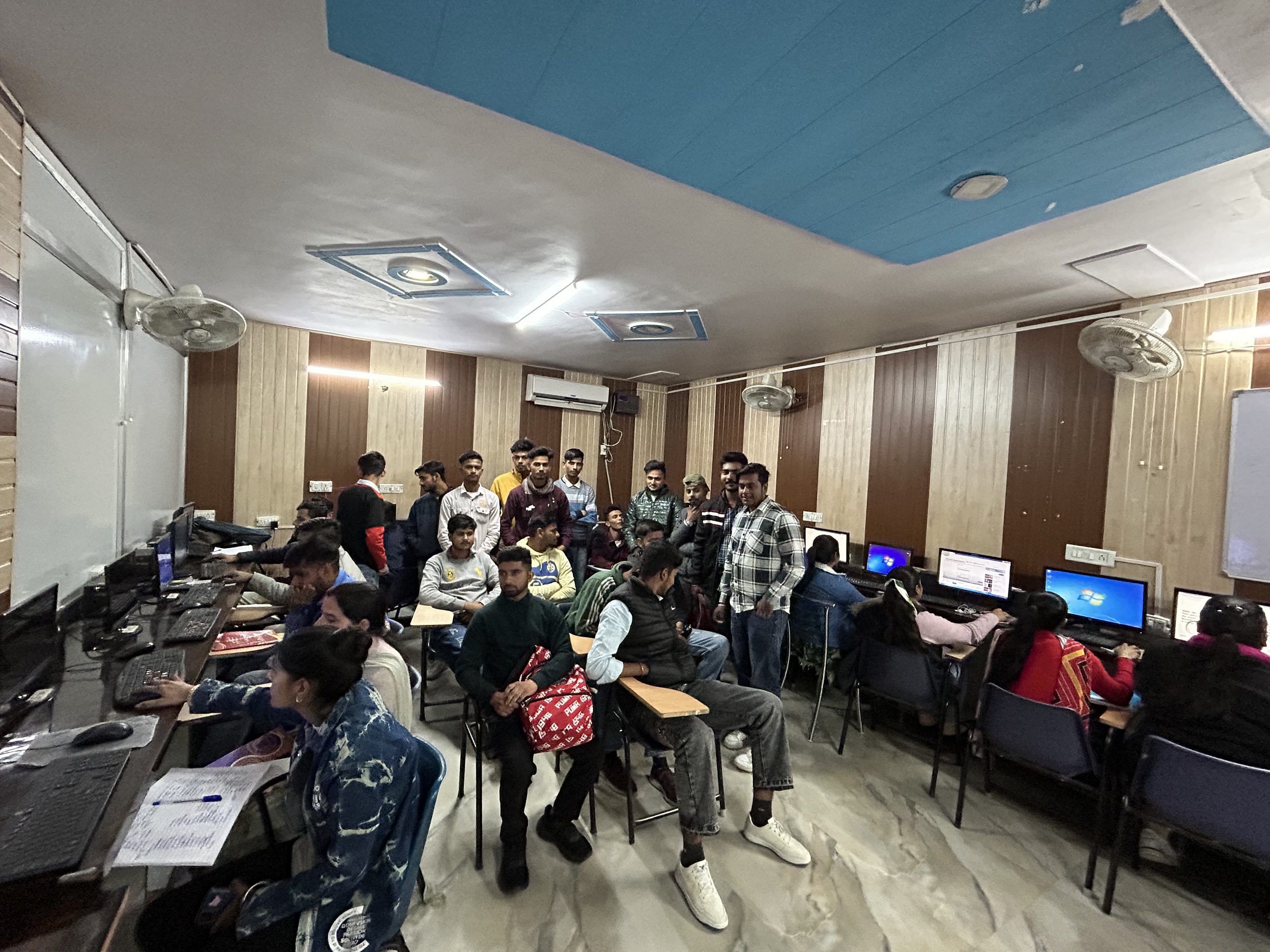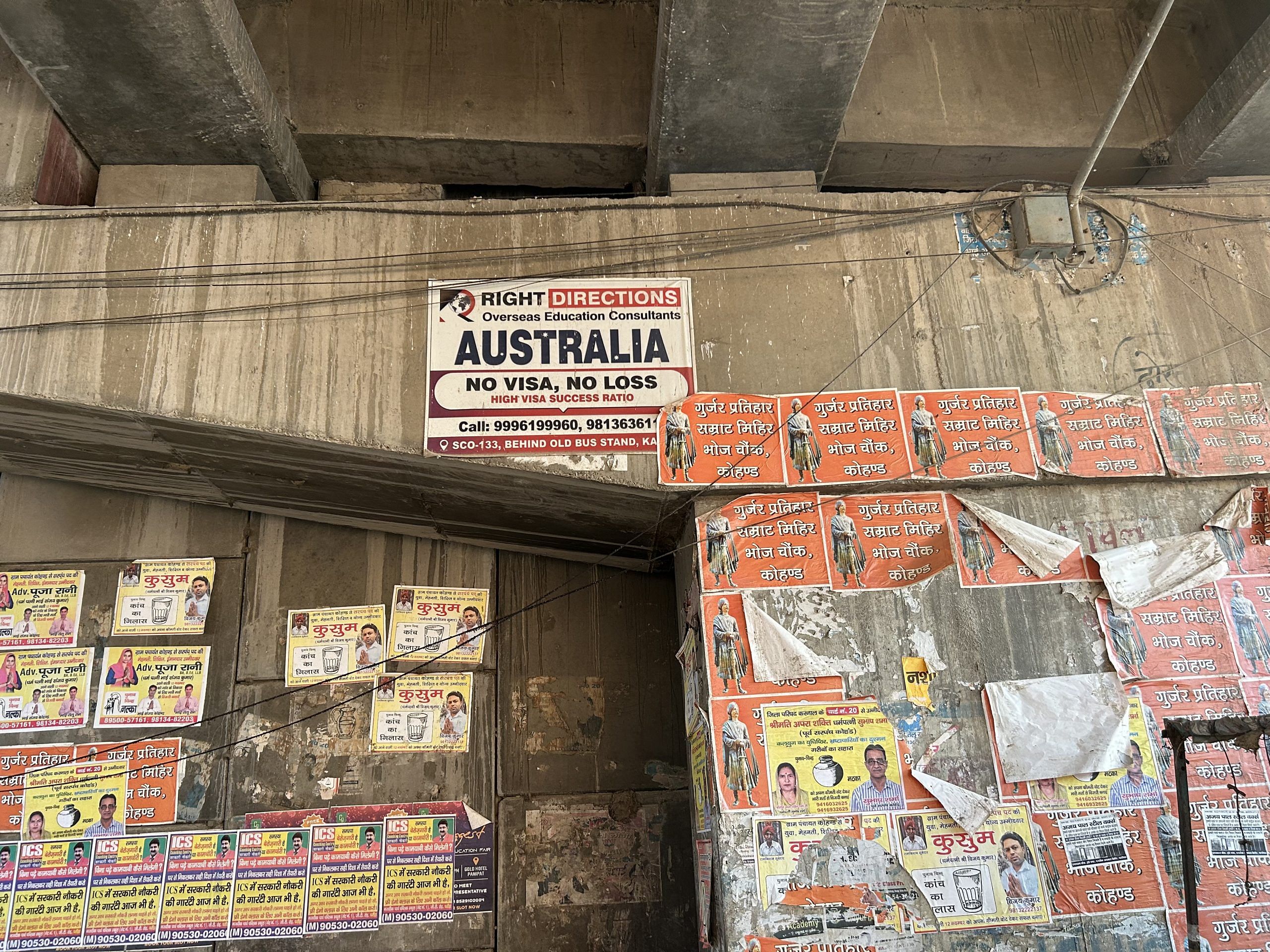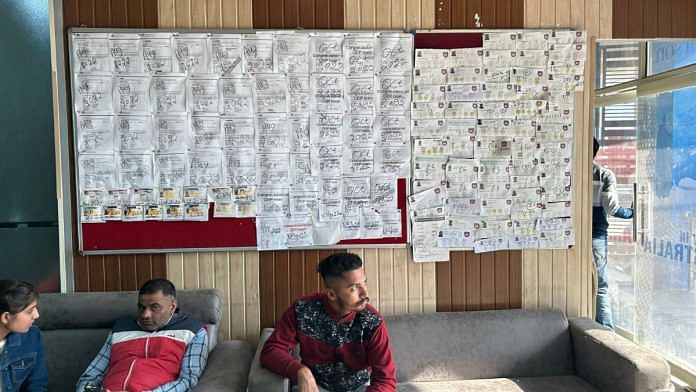Jind/Kurukshetra: There’s a giant US-style open, neon-green, modular kitchen in the Sharmas’ two-floor home in Haryana’s Dhatrath village. It has a parking garage and a 50-inch TV playing Instagram reels of American life all day. From the banal to the breathtaking, it throws up clips of cute toddlers bundled up in their woollens walking in the countryside snow, idyllic animal farms, and trucks rumbling on highways.
The house is a loud declaration to villagers and outsiders that three of their sons have migrated to the United States.
Rural Haryana is now the new Punjab in its race to send its youth to the US, UK, and Australia. Rows of IELTS coaching, visa centres, and agent offices line up small-town marketplaces. A new vocabulary has gripped Haryana villages, with words like PR for permanent residency, work permits, and dependents replacing popular acronyms for prestigious state universities like Maharshi Dayanand University and Kurukshetra University.
Rural unemployed youth are selling their family land and gold, getting basic nursing and accountancy diplomas, enrolling in English courses, and mastering the American twang after watching YouTube videos as their first steps toward their NRI dream. The new exodus spans across castes. Jats, Sainis, Brahmins, Scheduled Castes – are all fleeing. Farming is not an aspirational option anymore. They say they are escaping the toxic cycle of joblessness, entrance exam paper leaks, and chronic delays in recruitment.
“Yeah, right, right,” says Nischay Sharma (20), speaking on his latest iPhone 14 Pro with an American drawl. He used to say ‘hambe’ earlier, the Haryanvi word for ‘yes’ or ‘okay’.
Sharma is visiting home for a month from California, where he works with a transport company. As he walks about wearing his red sneakers and a heavy gold chain, 12-year-old Harshit follows him around like a shadow. He too wants to go to the US.
For the Class 7 student, who goes to Oxford Public School in a nearby village in Jind district, America is the land of big cars, even bigger dreams, and bright lights. He follows all the WhatsApp and Facebook posts and Instagram reels that his cousins who work abroad share.
“His heart isn’t in studying at all. All day he is dreaming about going to the US,” says his grandmother. She laments the impressionable boy’s lack of focus.
Sharma’s home is easy to find. The double-storeyed structure is a landmark in itself. “Oh, the one whose sons are in the US? Oh, the one who built the kothi (bungalow)?” villagers say. The kitchen, with its gleaming tiles and shelves, puts even the modular units in Delhi flats to shame. It’s a world apart from the neighbouring house, where the bricks are blackened by smoke rising from the chulha ( stove). A son will soon be going to America, and their fortune may change.
But behind this paisa (money), prestige, and pride is the illegal route to a foreign country, locally known as “donkey”. For all his flexing, Nischay Sharma is part of a thriving “donkey culture”.
Dhatrath, Morkhi, and Kalwa are some of the villages in Haryana’s Jind district that are known to be the hubs of “donkey” seekers. They fly to Dubai on a tourist visa, live in shady hotels without adequate food, and move from one country to another in secret containers, walk for days on snow, or jump border fences to reach their dreamland.
A “No visa, no loss” graffiti lures those who want to migrate illegally.
“More than 100 young men have left Dhatrath in the last six to seven years. Some left when they were as young as 15 years. In fact, the moment they pass Class 10, they start preparing for the ‘number 2’ route now,” the newly elected village head, Birbal, claims.
Two months ago, 18-year-old Mohit, Nishchay’s youngest brother, embarked on the same journey. And five years ago, his eldest brother Lakshya left his village via the “donkey” route. “This family’s rise has driven people to either jealousy or inspiration,” Birbal adds.
Also read: K-pop in Ekta Kapoor serials — the Korea-India YouTube boom no one saw coming
The touts
The desperation to seek their fortune in other countries has engendered a nascent industry of touts and agents, helpers and hustlers. Apart from Jind, districts like Karnal and Kurukshetra are also emerging as such hubs. They attract hundreds of hopeful young men from Sonipat, Rohtak, and Hisar.
“First they try the student visa route, and if that is rejected, they either turn to the illegal route or become agents themselves,” says Bhupinder Khanpur, co-owner of the Cambridge Education and Immigration Point in Kurukshetra’s Ladwa town.
Sangita Dahiya, who runs a consultancy firm for students seeking visas to the UK, has observed a similar trend in London.
“Earlier, the districts adjoining Punjab were influenced by migration to Canada and Australia, but now there is a huge demand for student visas from Haryana,” says Dahiya. She processes 14-15 visa applications every month.
“Some are earning Rs 3-4 lakh per month here for the same jobs for which they get barely Rs 25,000 in India,” she says. Nursing, driving, and managing stores are some of the more popular jobs that promise a secure income.
But the insidious rise of touts peddling the “donkey” route is giving immigration officials regular migraines. Touts charge between Rs 25-60 lakh to shuffle people to other countries, without any money-back guarantee if a “client” is caught and deported back to India.

South and Central America are the more popular entry points to the US. In fact, India is the fifth largest source of illegal migrants entering the US through its southwest border, according to a report in The Economic Times.
It’s a dangerous journey undertaken in extreme temperatures with no guarantee of food and shelter. In January 2022, a family of four, including two children aged 3 and 11 years, were found frozen to death about 10 metres from the US border.
Nishchay approached a tout who had “helped” at least three to four other men from Dhatrath and neighbouring villages. His four uncles helped by contributing Rs 6 lakh each.
Average in studies, Nishchay had no hope of securing a college seat or getting a well-paid job. “I got lucky within five months. I reached California crossing nine countries, jungles, and facing extreme weather. Sometimes, the journey can take two years. They are beaten up, locked, and sometimes killed,” he explains.
But he doesn’t want to talk about the route he took. He’s also cagey about where he’s based in California, the nature of his work, and whether his documents are in order. He flew to India and plans to take a flight back to California after a month.
Dhatrath village has a permanent cracker shop that does brisk business all through the year, not just during Diwali. Every time a son makes it safely to his final destination, his family celebrates by bursting crackers. Often, the silence of the village is broken by loud fireworks when as many as three families start celebrating at the same time. It’s their way of letting the village know that their sons are safe.
It’s a rite of passage of sorts. And waiting in the wings is a young Harshit. He’s counting down the years for when he will leave Dhatrath. Maybe his family will one day buy crackers to burst in his honour.
Also read: Nashik vineyards recreating Napa Valley experience in India—with ‘bhakri-wine’ tours
Desperately seeking visas
On a late December afternoon, the Cambridge centre in Ladwa is packed to the rafters with people seeking visas. They’re armed with files and folders bulging with forms, certificates, and documents – original and copies. At the reception, two female employees seem overwhelmed by the sheer number of applicants.
Two Haryana policemen in uniform stand out in the crowd. They’re here to consult with the agents about their sons’ prospects abroad.
The receptionists ask some people to wait and usher others into the manager’s cabin. Tea and biscuits are served to make the wait bearable. People settle down and gaze longingly at the walls plastered with laminated photographs of successful applicants.
Bhupinder Khanpur started Cambridge Education and Immigration Point with a relative, Jasbir Panjeta, in 2012. Both men had applied to migrate to Australia and then Singapore but were rejected. “By then, we knew the whole process, and it looked like a good business idea. In the local language, we are agents, but more sophisticatedly, we are consultants,” says Panjeta.
For each visa application that costs a minimum of Rs 18-20 lakh, the duo earns a commission of Rs 40,000-50,0000. Every month, they are able to clear five to six files. The business has never been better. And they have an office in Australia as well.
“Today’s rejected applicant is the future agent,” says Bhupinder. The centre, which was registered with the DC office in 2014, trains aspirants for the IELTS, the English language international standardised test, and also processes visas. Today, they have 500 visa applications under process and 220 students enrolled in the IELTS course.
Arun Sharma (23) relocated from Sonipat’s Ganaur to Ladwa to prepare for the IELTS. He’s living with his brother, a sub-inspector with the Haryana Police. He’s convinced that all doors in India are closed for him, even with a BA and an MA from Maharshi Dayanand University. He took the Railway Protection Force exam in 2019 and then the Haryana Police exam in 2021, but with no success. “Now in 2022, all I want is to get a student visa and move out,” he says, the frustration evident in his voice.
In the 1990s, there were a maximum of two to three consultants in Ladwa. At the time, Australia was the most sought-after destination. But now, there are more than 200 such centres. Here, rejection feeds the spirit of entrepreneurship.
“People whose applications are rejected at our centres have opened shops in the neighbourhood. More than two dozen agents have approached us for their applications,” says Panjeta. Both he and Khanpur laugh uproariously.
From intermediate to PhD degree holders, everyone is desperately seeking visas. The town’s overbridges, monuments, and public places are plastered with promises of “No Visa, No Loss” to Australia, the UK, and the US. And they offer a special discount for girls as well.

Village without youth
At Sheikhupura village in Karnal district, elderly men can be seen smoking hookahs in groups. The women work in fields and kitchens, while the children play on the streets.
But the young men are missing.
Over the last five to six years, at least a hundred people – some as young as 16 years – have left for other countries, claims a village elder.
“Some have jobs, but recently everybody is leaving for a foreign country,” says 45-year-old farmer Suresh Kumar Ghanghas. “But ours is not an isolated case. Kheri Naru and Ghogripur villages are also sending their youth abroad.”
He blames the trend on the lack of opportunity and the intense competition for a limited number of seats in colleges and universities. Ghanghas says he got an MA degree from Kurukshetra University in 1999. Unable to find a “decent job,” he turned to kheti-baadi (farming).
“But this generation will not work in the fields. They have aspirations to lead a good lifestyle,” says Ghanghas, who has three children. His eldest daughter is completing her PhD in engineering at Netaji Subhas University of Technology, New Delhi. Another is preparing for the UPSC. But his 20-year-old son Satyam is in Los Angeles getting a B.Tech degree in computer science.
“But he took the legal route, not the ‘number two’,” he says with pride. He shelled out Rs 18 lakh for the visa fee, agent commission, plane ticket, and tuition fees for a few months.
Ghanghas farms 10 acres of land but has taken another 50 acres on lease. His neighbour, Ranbir Singh, who lives with his six brothers, their wives, and children, is tilling the land to send their children abroad. Four sons have already gone to other countries on student visas; the fifth is in the process of applying.
The youngest child in the family, 17-year-old Tanishak, is in Class 12 and already planning his life in America. He doesn’t fret over his area of study or career. The goal is to reach America; the rest will follow. “I haven’t decided on the course yet but I’ll take what I get,” he says.
Even the former village head left for the US via the “donkey” route a few months ago with his wife. “He and his wife are in some stage of the journey, but no one knows which country they will end up in,” says Ghanghas
Also read: Allahabad HC suggestion to include transgenders in OBC list will be a disaster
Rural distress and unemployment
Blue-collar migration to the West was synonymous with Punjab for decades, but it is a little surprise that Haryana is catching up now. According to the Centre for Monitoring Indian Economy’s September report, Haryana recorded the highest unemployment in India, four times that of the national average.
Rising inflation and rural distress are some of the reasons behind this rising unemployment rate in India, the report reads.
“They don’t want to work in the fields anymore. But there are no other jobs either. Each day, we wake up to the news of protests and paper leaks. The youth want to buy the latest mobile phones. They want to drive new cars and wear branded clothes. What is the other way to afford this lifestyle?” asks Nishchay’s uncle Ashwini Sharma.
Disillusioned by the corrupt system, most youths don’t see the point of pulling themselves up by the bootstraps for a job that will pay them a mere pittance. Certainly not enough for cars, iPhones, and branded clothes.
Local newspaper headlines detailing scams and paper leaks are cropping up with increasing regularity.
“Three more are arrested in Haryana police recruitment paper leak, 67 nabbed so far,” reports a local newspaper on a recruitment scam. In May 2022, another report in Jagran gave details on the biggest paper leak in Haryana, with links all the way up to Kashmir. The entire recruitment and exam system has been plagued by paper leaks, which became a key electoral issue in the 2019 assembly elections.
In August 2021, the Haryana government had to introduce a bill – The Haryana Public Examination (Prevention of Unfair Means) Bill – to curb this menace.
“The Army requirement delay and the Agniveer scheme too has played a crucial role in the overwhelming number of aspirants approaching us,” said an agent who runs a “donkey business” in Jind.
Also read: Mathura Muslims are ready for legal fight. But Hindus being galvanised for historical justice
Women not far behind
In recent months, visa agents like Cambridge have started seeing a rise in young women seeking their fortune in other countries. And they’re not going through the traditional marriage visa route.
“Entry of girls in this area is a new thing,” says Bhupinder Khanpur. Families who don’t send their daughters to Delhi University or other well-established institutes have started exploring opportunities in the UK, Canada, and Australia for either jobs or degrees.
In Sheikhupura village, two young women have already gone abroad – legally.
At the Cambridge centre in Ladwa town, a man sat patiently waiting for information on visas for his two daughters.
On the second floor, 19-year-old Riya Vaid is learning to speak fluent English so she can clear the IELTS. She wants to go to Australia to do her master’s in computer science. She is the first in her family to get a degree. Her parents are daily-wage workers.
“Air first, it was difficult to convince my parents. But now, they have understood that Australia is safe for girls and I can earn much more there,” says Vaid, a B.Sc graduate from Kurukshetra University.
Ashu Devi (29), a mother of two, has made it her mission to go to Cardiff University in Wales. She took charge of “mission UK” when her husband Nirmal, an electrical engineer, left his job in Gurgaon and returned to the Rajepur village.
“He was earning only Rs 30,000 in Gurugram. How can a family of four survive on so little?” says Ashu. The Cambridge agents she is consulting with have promised that her application will be processed in a few months and that she will get her visa by April 2023. The five acres of land that her husband will inherit from his father will help them.
Ashu does not wish to return and is already making plans to get a work permit after which her husband and children will join her as dependents.
But she dreads interviews.
“Please make sure I can escape the interview part,” she requests the agents.
(Edited by Tarannum Khan)



